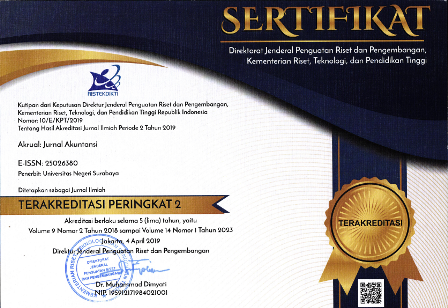The Influence of Profitability, Executive Character, and Company Size on Tax Avoidance
DOI:
https://doi.org/10.26740/jaj.v17n1.p180-187Keywords:
Company size; Executive character; Leverage; Profitability; Tax AvoidanceAbstract
Research Background: A Limited Liability Company (PT) that has deposited or traded at least 40% of its shares on the IDX from the total shares it owns and has fulfilled certain requirements is an example of a domestic corporate taxpayer. Companies, especially Limited Liability Companies that have entered the capital market or the Indonesian Stock Exchange, have become taxpayers and are required to pay, withhold and collect tax.Introduction/ Main Objectives: This study aims to analyze the effect of profitability, executive character and company size on tax avoidance with leverage as an intervening variable. Methods: The population of this study consisted of 220 zompanies listed on the Indonesia Stock Exchange (IDX) during the period 2020-2024, with sample of 61 companies selected through a purposive sampling method. The data used are secondary data that are quantitative in nature. The analysis method used is path analysis to identify direct and indirect effect using SPSS 22 Software. Results: The data was proceed using path analysis and the results showed that profitability, executive character and company size did not affect the company’s tax avoidance with leverage as and intervening variable.
References
Carolina, V., Natalia, M., & Debbianita, D. (2014). “Executive Characteristics of Tax Avoidance with Leverage as an Intervening Variable.” Journal of Finance and Banking, 18(3), 409–419. https://doi.org/10.26905/jkdp.v18i3.819
Danilla, C., & Septiani, D. (2023). "The Influence of Thin Capitalization, Company Size and Profitability on Tax Avoidance." Journal of Accounting Research, 15(1), 84–95. https://doi.org/10.34010/jra.v15i1.9372
Dari, W., & Huda, M. F. A. (2021). "Environmental Social Accounting: Managerial Decisions and Sustainability of Social Entrepreneurs in Vulnerable Communities (Experimental Evidence from Indonesia)." EBBANK, 11(2), 65–78. https://ebbank.stiebbank.ac.id/index.php/EBBANK/article/view/212
Dyreng, S. D., Hanlon, M., & Maydew, E. L. (2008). “Long-run Corporate Tax Avoidance.” The Accounting Review, 83(1), 61–82. https://doi.org/10.2308/accr.2008.83.1.61
Fatiha, A. S. & Murtanto. (2024). "The Influence of Profitability, Capital Intensity, Financial Distress, Sales Growth, and Leverage on Tax Avoidance." Digital Economy, 3(1), 1–12. https://doi.org/10.55837/ed.v3i1.109
Hendayana, Y., Arief Ramdhany, M., Pranowo, A. S., Abdul Halim Rachmat, R., & Herdiana, E. (2024). “Exploring Impact of Profitability, Leverage And Capital Intensity on Avoidance of Tax, Moderated by Size of Firm in LQ45 Companies.” Cogent Business & Management, 11(1), 2371062. https://doi.org/10.1080/23311975.2024.2371062
Kasmir, S, 2012. “Alternatives to capitalism and working-class struggle: A comment on Alice Bryer’s “the politics of the social economy”, Dialectical anthropology, Vol 36.
Low, A. (2008). Managerial Risk-taking Behavior and Equity-based Compensation (SSRN Scholarly Paper No. 934857). https://doi.org/10.2139/ssrn.934857
Muzharoatiningsih, M., & Hartono, U. (2022). "The Influence of Financial Ratios, Sales Growth and Company Size on Financial Distress in the Consumer Goods Industry Sector Listed on BEI" 2017-2020. Journal of Management Science,747–758. https://doi.org/10.26740/jim.v10n3.p747-758
Puspita, D., & Febrianti, M. (2018). "Factors that Influence Tax Avoidance in Manufacturing Companies on the Indonesian Stock Exchange." Journal of Business and Accounting, 19(1), 38–46. https://doi.org/10.34208/jba.v19i1.63
Rahmadani, Kurnia, Edfan Darlis, and Pipin Kurnia. 2021. "Corporate Environmental Disclosure: Viewed from Profit Management and Good Corporate Governance Mechanisms." Current: JOURNAL OF CURRENT ACCOUNTING AND BUSINESS STUDIES 2, no. 1 (April): 94–107. https://doi.org/10.31258/jc.2.1.94-107.
Rahmawati, D., & Nani, D. A. (2021). "The Influence of Profitability, Company Size, and Debt Levels on Tax Avoidance." Journal of Accounting and Finance, 26(1), 1–11. https://doi.org/10.23960/jak.v26i1.246
Ratih Qadarti Anjilni & Fikri Fahrezi. (2024) "The Influence of Executive Character, Financial Performance and Company Size on Tax Avoidance." Journal of Accounting, Economics and Business Management, 4(1), 49–57. https://doi.org/10.55606/jaemb.v4i1.2826
Rismanto, R. (2024). "Application of ESG (Environmental, Social, Governance) in Financial Investment Strategy." INVESTI : Jurnal Investasi Islam, 5(1), 601–616. https://doi.org/10.32806/ivi.v5i1.186
Rosa Amelia & Rinny Meidiyustiani. (2024). "The Influence of Profitability, Company Age, Leverage and Company Size on Company Value." Jurnal Mutiara Ilmu Akuntansi, 2(3), 201–217. https://doi.org/10.55606/jumia.v2i3.3221
Sari, N., Luthan, E., & Syafriyeni, N. (2020). "The Influence of Profitability, Leverage, Independent Commissioners, Institutional Ownership, and Company Size on Tax Avoidance in Manufacturing Companies Listed on the Indonesian Stock Exchange in 2014-2018." Batanghari University Jambi Scientific Journal, 20(2), 376. https://doi.org/10.33087/jiubj.v20i2.913
Setiawati, L. W. (2018). "Analysis of the Influence of Profitability, Company Size, Leverage, and Social Disclosure on Company Value in Manufacturing Companies Listed on the Indonesian Stock Exchange for the 2011-2015 Period." Accounting Journal, 12(1), 29–57. https://doi.org/10.25170/jara.v12i1.57
Siti Mustafidah & Hari Stiawan. (2022). "The Effect of Executive Character, Executive Compensation, and Capital Intensity on Tax Avoidance." SOSMANIORA: Jurnal Ilmu Sosial Dan Humaniora, 1(3), 313–321. https://doi.org/10.55123/sosmaniora.v1i3.790
Sofiamanan, N. Z., Machmuddah, Z., & T.A.H, N. (2023). “Profitability, Capital Intensity, and Company Size Against Tax Avoidance with Leverage as an Intervening Variable.” Journal of Applied Accounting and Taxation, 8(1), 21–29. https://doi.org/10.30871/jaat.v8i1.4821
Sugiyono. 2007. Educational Research Methods: Quantitative, Qualitative, and R&D Approaches.3rd ed. Bandung: Alfabeta.
Waskito, W., Zuhrotun, Z., & Rusherlisyani, R. (2019). "The Influence of Economic Growth, Original Regional Income, General Allocation Funds, Special Allocation Funds, and Profit Sharing Funds on Capital Expenditures (Study of Regency & City Governments in Aceh Province)." Indonesian Accounting and Business Review3(2). https://doi.org/10.18196/rab.030247
Downloads
Published
How to Cite
Issue
Section
License
Copyright (c) 2025 Sugiharto Sugiharto, Carlos Afonso Baretto, Aditya Ramadhani Kurniawan

This work is licensed under a Creative Commons Attribution-NonCommercial 4.0 International License.
 Abstract views: 254
,
Abstract views: 254
, PDF Downloads: 143
PDF Downloads: 143

















